
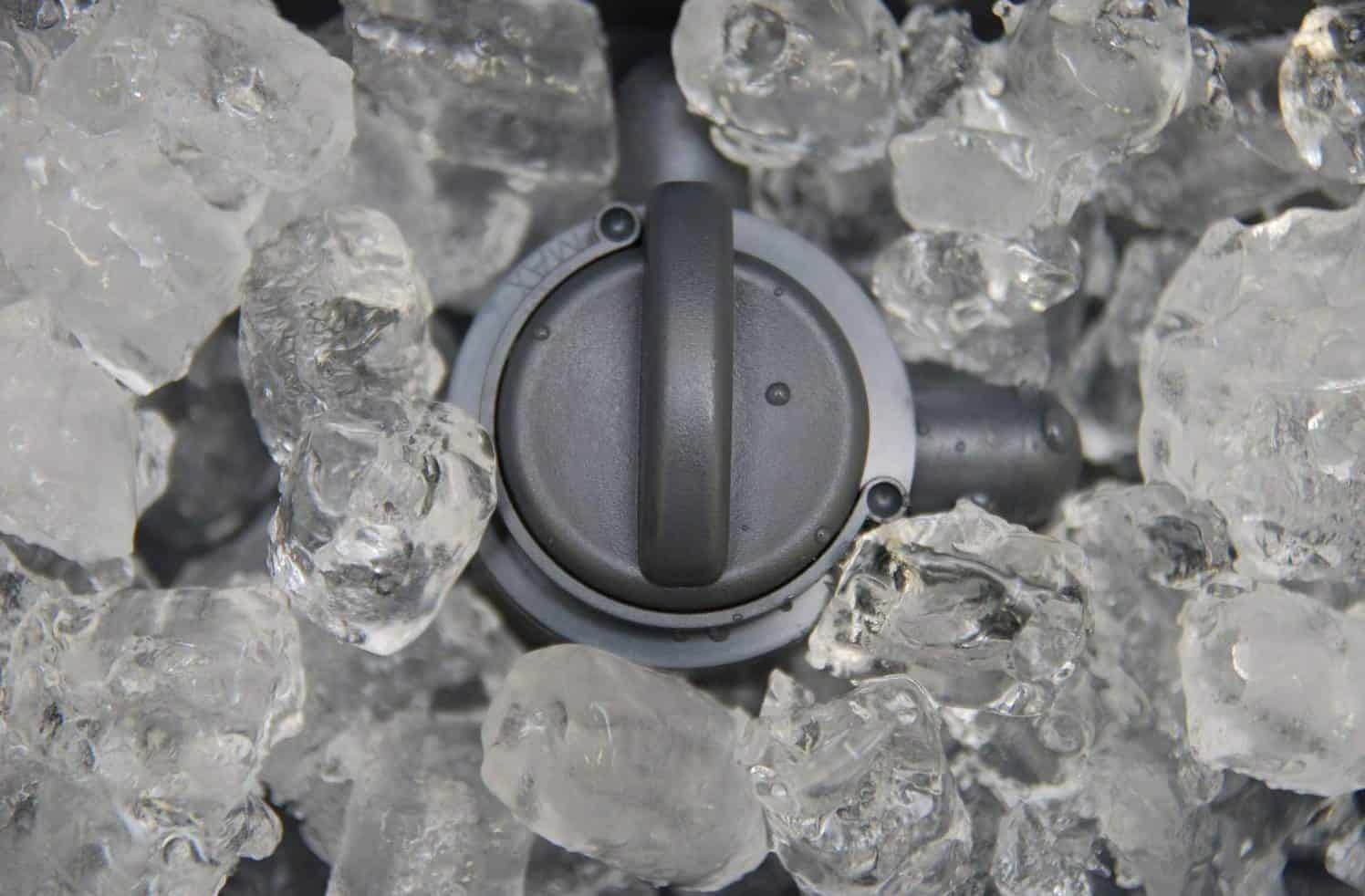
Winter is coming. Eventually. But right now you need the best evaporative cooler to keep you cool this summer. Read our reviews before you buy!
 Honeywell 525 CFM Indoor Portable Evaporative Cooler
with Fan & Humidifier
Honeywell 525 CFM Indoor Portable Evaporative Cooler
with Fan & Humidifier
Can be adjusted to imitate natural wind
Allows you to adjust the level of humidification
Some users report a strange odor
Needs to be cleaned monthly
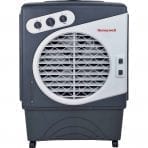 Honeywell Powerful Outdoor Portable Evaporative Cooler
Honeywell Powerful Outdoor Portable Evaporative Cooler
Fast air circulation
Can be used both indoors and outdoors
Can be complicated to clean
Not suitable for small spaces
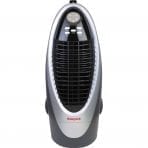 Honeywell Indoor Portable Evaporative Cooler
with Fan & Humidifier
Honeywell Indoor Portable Evaporative Cooler
with Fan & Humidifier
Takes up very little space
Features a user-friendly display
Only efficient for spot cooling
Filling the water tank is inconvenient
Quilo QE1SKS 3in1 Quiet Low Energy Portable Tower Fan with Evaporative Cooler & Humidifier
The best feature of this cooler is that it’s amazingly quiet. It’s meant for smaller spaces, features a fan, evaporative cooler, and humidifier, and has three cooling speeds. It’s also amazingly energy efficient.
Can be set to use very little energy
Dust, hair and similar particles can’t enter the water tank
Can’t be used outdoors
Filling the water tank is inconvenient
Essick Air Window Evaporative Cooler
With a massive cooling capacity of 1,400 square feet, this unit is great for large spaces. It features two cooling speeds, adjustable air vents, and leveling leg, and is very durable and reliable.
Resistant to rust
Highly durable
Phoenix Manufacturing BW4002 Evaporative Window Cooling
Quick cooling is the name of the game here. With a cooling capacity of 1,000 square feet, this unit will cool down large rooms very quickly (CFM: 4,000). It provides a 15 to 28% reduced energy cost, is quiet, and comes with a 10-year warranty for rust.
Doesn’t need to be refilled
15 to 28% reduced energy cost
Large and heavy
Replacement parts can be difficult to find
Luma Comfort EC111B Portable Evaporative Cooler
Meant for small and medium spaces, with a CFM of 500 and a two-gallon tank, this stylish and well-designed unit offers functions of a cooler, fan, and humidifier, as well as three cooling speeds and wind modes with an oscillation option. It can lower indoor temperatures by as much as 30°F and is easily portable.
Water tank easy to manage and clean
Visually enticing
8 Amazing Evaporative Cooler Reviews 2026

He works in a large company as an interior designer. Art critic and professional in the field of design.
Mingmei Liang The sun is blazing and the sweat is pouring, which can only mean one thing. It’s time to get your hands on the most efficient cooling method possible. Air conditioning is one of the most common ways people make sure they breathe only fresh air. But in some climates, the expense that comes with it is just too much. That’s why we’re going to introduce you to the best evaporative cooler out there.
The sun is blazing and the sweat is pouring, which can only mean one thing. It’s time to get your hands on the most efficient cooling method possible. Air conditioning is one of the most common ways people make sure they breathe only fresh air. But in some climates, the expense that comes with it is just too much. That’s why we’re going to introduce you to the best evaporative cooler out there.
Here’s the deal:
Evaporative coolers might not sound as efficient as AC units, but they’re actually quite powerful. If you live in a hotter climate that’s humid at that, this type of cooling method might be the best choice for you. And considering the number of brands out there, you’ll surely find a unit that fits all your needs. And we’re here to help guide you through the process.
If you need to cool down, get higher humidity in your space, or just enjoy a breeze, the Honeywell 525 CFM is a quality choice. Honeywell specializes in producing great evaporative coolers, and this unit is a great example.
This unit is meant to be used in small to medium spaces and it performs best in places where humidity is under 60%. It has a CFM of 525 and has a cooling capacity of 320 square feet. This makes it great for campers, garages, or single rooms, but it is not suitable for use outdoors.
However:
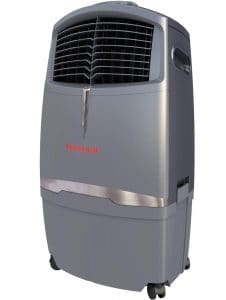 This unit features three appliances in one – a fan, a cooler, and a humidifier. If you only want a breeze, you can just use the fan function to cool down. We’ve found that one great thing about this unit is that it can be adjusted to imitate natural wind.
This unit features three appliances in one – a fan, a cooler, and a humidifier. If you only want a breeze, you can just use the fan function to cool down. We’ve found that one great thing about this unit is that it can be adjusted to imitate natural wind.
If you want to lower the temperature in your space, then you can use the cooler function. Simply put water or ice in their respective compartments. This unit provides a powerful airflow, while still using a relatively low amount of power – 288 W.
During winter months, this unit can be used to add some humidity to your space. It can easily be adjusted to fit anyone’s preferences because it features three cooling speeds, including Sleep Wind Mode, and it also has an adjustable knob for controlling the humidification level.
There are a few more handy features to this unit. Namely, it has a timer which you can set to turn off the machine. This saves you effort and is energy efficient. The unit can also be controlled remotely with the full-function remote control.
It gets better:
This unit is also great for people with various allergies because it features an Activated Carbon dust filter. The water tank can be fully removed, which makes it easy to fill and clean. There’s also a separate ice compartment. When the water levels in the tank become low, there’s a handy alarm which lets you know your cooler needs to be refilled.
Our research showed that this unit is built extremely sturdily. It features Honeycomb cooling media, which means it has special cooling pads engineered from thick cellulose paper. This makes them resistant to deterioration, and they provide amazing cooling, low pressure drop, and will last for years.
There are a few downsides to this cooler. It has to be cleaned more often than some other coolers. While researching it, we’ve found that it’s best to clean it once a month. Also, some users have reported that after a while the unit starts emitting a strange odor and that cleaning it out is a huge hassle.
The unit also features quality rollers, which means it’s easy to move around. All in all, this is a good choice for an inexpensive cooler for smaller spaces. Just make sure you’re in the right climate before buying this unit!
Can be adjusted to imitate natural wind
Allows you to adjust the level of humidification
Some users report a strange odor
Needs to be cleaned monthly
If you’re looking for a quality evaporative cooler, the Honeywell CO60PM is a great choice. Honeywell is a reputable company known for making user-friendly and powerful devices, which is evident in this product.
The CO60PM provides you with a delightfully cool breeze. It has a huge tank capacity of 15.9 gallons and has a CFM of 1540. The unit is quite large, so it’s not suitable for small indoor areas. However, it can be used both indoors and outdoors, and our research has found that many people use it to cool down their backyard or patio.
With the UV protection featured in this product, you can easily keep it outside without risking issues. It can function unattended for a long time, be it throughout the night, or all through a picnic, family gathering, etc.
This product features three appliances in one – an air cooler, a fan, and a humidifier. When you switch the unit on, the fan creates a breeze by blowing the existing air out. If this air is too warm for your tastes, you can simply add water and/or ice to the tank, and the unit transforms into a cooler.
The unit also uses the water and ice to create humidity, which makes it great for dry climates, but avoid buying it if you live in a humid area (the recommended level of humidity is under 60%). Also, smaller spaces tend to become really humid when using this unit, which is another reason why it’s not recommended for small indoor areas.
Now get this:
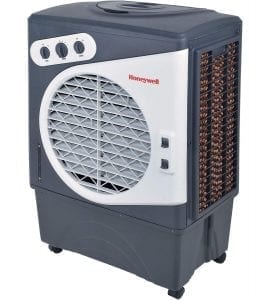 The CO60PM comes with three fan speeds, and we’ve found that most users find the lowest setting to be powerful enough for residential spaces. The unit is great for whole-room cooling because it cools on three sides, not just from the front. It also has oscillation modes, and many users enjoy the fact that the unit can blow air both from side to side and up-down.
The CO60PM comes with three fan speeds, and we’ve found that most users find the lowest setting to be powerful enough for residential spaces. The unit is great for whole-room cooling because it cools on three sides, not just from the front. It also has oscillation modes, and many users enjoy the fact that the unit can blow air both from side to side and up-down.
When it comes to energy efficiency, this is one of the better models out there. Considering it has a huge cooling capacity, this unit has minimal energy consumption, while also having maximized airflow. It provides fast air circulation and consumes a low amount of power.
The unit is sturdily built with high-quality materials, and it’s quite large. But the wheels on this unit make it extremely easy to move around. Also, we’ve found that the controls are easy to understand and use, even for new users who have never used an evaporative cooler before.
You might be wondering:
Are there any downsides to using this unit? Many users complain that the unit can be complicated to clean because you need to unscrew a few pieces to get to the inside. Also, if you’re a pet owner, be aware that the unit can attract pet hair which is difficult to clean off. The material makes the pet hair stick to the pads, so you might need to cover them from the outside to prevent any hassle.
Another huge pro for this unit is the company itself. Although users sometimes have issues with certain parts arriving faulty or broken, the company offers amazing customer service, with spare parts being delivered free of charge in a short amount of time, and returns are also handled professionally.
Fast air circulation
Can be used both indoors and outdoors
Can be complicated to clean
Not suitable for small spaces
Honeywell is a great company which produces high-quality evaporative coolers, and this one is no exception. The Honeywell CS10XE is a triple threat that will fit nicely into any home or office.
This unit is basically three appliances in one. It can function as a fan, as an evaporative cooler, and as a humidifier. It’s perfect for smaller rooms such as bedrooms, living rooms, and dining rooms because it has a 100 square feet cooling capacity.
The Honeywell CS10XE features three cooling speeds, including Sleep Wind Mode which imitates natural wind. It also has a knob that allows you to easily adjust your preferred level of humidification. In the summer, you can use this device to cool down your room, and in the winter, it can function as a convenient humidifier, giving you a higher perceived temperature.
Want to know the best part?
 The convenient off timer which can be used to automatically shut the device down is just one of the things that make the Honeywell CS10XE energy efficient. It also uses just 102 W of power, which is approximately the same as a laptop.
The convenient off timer which can be used to automatically shut the device down is just one of the things that make the Honeywell CS10XE energy efficient. It also uses just 102 W of power, which is approximately the same as a laptop.
It has a non-compressor system which provides efficient cooling without using a lot of power. The ice compartment allows for even better, faster, and more natural cooling. The unit saves up to 90% on energy costs. It has a removable water tank which is easy to fill, and it automatically lets you know when it’s time to refill the tank.
The Honeywell CS10XE is designed to be compact and take up very little space, and it can easily be moved from one place to another because of its small size, lightweight, and rollers. It’s also quite silent, with a median sound level at high speeds of 57 dB.
The Activated Carbon Air Filter in the unit is great for filtering unwanted particles from the air, which makes it perfect for people who are sensitive to dust. It also features a handy display which is easy to read and use. And if you don’t want a lot of hassle, you’ll be glad to know that the Honeywell CS10XE also comes with a remote control.
However:
Although this device provides quick cooling, it’s not great for larger spaces, and it works best for spot cooling. This means that it’s best used to cool particular spots in your home such as your bed, desk, dining table, or couch. Another downside is that users report that the tank can be a hassle to fill.
But the good news is that our research showed that the company’s customer service is quite good, so if there’s a kink with your device, they’re quick to answer and eager to solve any problems.
Takes up very little space
Features a user-friendly display
Only efficient for spot cooling
Filling the water tank is inconvenient
The Cyclone 300 is a great evaporative cooler if you live in a hot and dry climate. This unit is made by Portacool, a reputable company which is known for their high-quality items ranging from HVAC products to industrial, commercial, and residential items. Before purchasing, check our Buyer’s Guide section to see if an evaporative cooler will work in your climate!
The Cyclone 3000 comes in a durable polyethylene housing which is made to be in one piece. The housing is resistant to rust and cannot leak. The only downside is that many users noted that the housing gives the unit an unappealing look. On the flip side, it’s very easy to clean.
The pump and motor function at an energy-efficient 5.6 amps. The Cyclone 3000 requires almost no maintenance, and it’s amazing at cooling spaces – it can lower the temperature by as much as 30 degrees.
Here’s where it gets good:
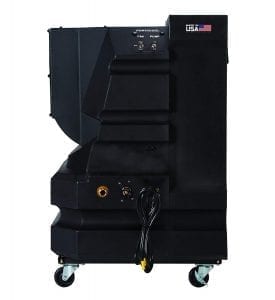 The Cyclone 3000 features a convenient water level sight tube, which lets you know at what level the water is. It also has a sump drain and a water hose connection. This means that the unit can be connected to a water supply line, so it can have a longer running time.
The Cyclone 3000 features a convenient water level sight tube, which lets you know at what level the water is. It also has a sump drain and a water hose connection. This means that the unit can be connected to a water supply line, so it can have a longer running time.
Apart from the water connection, the unit also has a water tank so you can fill it up manually. The tank has a 16-gallon capacity, which means the Cyclone 3000 also has a long running time even if it’s not hooked up to a water supply line.
This unit is great for medium to large spaces, as it has a cooling capacity of 700 square feet. It’s not suitable for smaller spaces, partly because it’s quite large in size. Also, the Cyclone 3000 functions quite well for outdoor cooling, and the durable caster wheels on this product enable you to transport and move it around easily, despite its size.
Now get this:
If you want your new evaporative cooler to be safe and protected, this Portacool vinyl cover fits all Portacool Cyclone models, including this one. The cover is made of thick black vinyl, which will keep your unit clean and protected when you’re not using it.
The cover also works great in all weather. It’s water resistant and it covers the unit snugly, so there’s no risk of wind blowing the cover away. It covers the whole unit – right down to the wheels. Our research showed that many users are extremely happy with this cover.
The Cyclone 3000 also features high-quality evaporative pads - KUUL Pads with media, which means it can easily use tap water and produce air that’s 10 to 25 degrees cooler.
When it comes to energy efficiency, this unit beats most others out there. It uses only 120 volts of power, which is less than half of what other, smaller units tend to use. Also, it doesn’t use refrigerant gas for cooling, so it’s very friendly to the environment.
When doing our research, we’ve found that this is one of the few units out there without an oscillating feature. This means that air just blows straight out, and although it can be adjusted to blow more up or more down, it cannot be rotated.
Another downside to the Cyclone 300 is that many users complain about problems when adjusting the water valve. But overall, this unit is a decent choice when looking to be energy efficient and cool medium to large spaces.
Can lower the temperature by 30 °F
Great for medium to large spaces
Doesn’t have an oscillating feature
Many users have issues with the water valve
The Quilo QE1SKS is a high-quality solution if you need to cool down your living or office space. Made by Quilo, a reputable company with excellent customer service, this unit features a honeycomb irrigation system, which can rapidly reduce the temperature of surrounding warm air, and transform it into a moist, cool breeze.
This unit is perfect for smaller spaces such as your bedroom, dining room, living room, or play area. It has three cooling speeds to choose from and an automatic off timer so you can leave it on during the night.
The Quilo QE1SKS is a great addition to any home because it features capabilities of three separate appliances in a single compact unit which saves you energy. It consists of a fan, an evaporative cooler, and a humidifier.
But guess what:
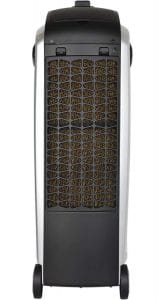 The fan also enables you to mimic a lovely natural lake breeze right there in your own home. The fan is incredibly silent and the quiet mode on the unit uses as little as 7.4 W – which is around the same amount of energy your tablet uses when it’s plugged in. What makes it even more energy efficient is that this unit doesn’t require either a heat-producing compressor or refrigerant gas.
The fan also enables you to mimic a lovely natural lake breeze right there in your own home. The fan is incredibly silent and the quiet mode on the unit uses as little as 7.4 W – which is around the same amount of energy your tablet uses when it’s plugged in. What makes it even more energy efficient is that this unit doesn’t require either a heat-producing compressor or refrigerant gas.
The evaporative cooler mode of the unit also works like a charm, reducing the temperature in your living area. The Quilo patent-pending motor inside the unit maximizes airflow while minimizing energy consumption. The airflow and moisture mechanism can be easily controlled, which means that the evaporative cooler can easily transform into a humidifier in the winter.
Another useful feature of the Quilo QE1SKS is a lovely low-energy LED light, which users say creates a nice glow in the dark, and it’s also used for viewing the water level in the tank. This is just one of the features that make this unit easy to maintain. It also has a low water level alarm.
There’s more:
The water tank in this unit can be easily removed for cleaning, it has a 1.85 gallon (7 liter) tank capacity, and there’s a filter that prevents dust and other particles from entering the tank. Ice can easily be added to the top tray, so the unit lowers the temperature of the space even more. The unit also features rollers, so you can easily move it around.
There are a few downsides to this cooler. Namely, it cannot be used outdoors. Also, some users have reported that filling up the water tank can be inconvenient.
Can be set to use very little energy
Dust, hair and similar particles can’t enter the water tank
Can’t be used outdoors
Filling the water tank is inconvenient
Do you want to lower the temperature in your home or office during the summer? Then an evaporative cooler is a great choice, provided you live in a suitable climate. You can check whether you can efficiently use an evaporative cooler in your area in the Buyer’s Guide section of our article.
The Essick N46W is a great choice if you’re on the lookout for a quality evaporative cooler. This unit is made from high-quality materials, and is great for cooling large spaces – up to 1,400 square feet! It can significantly lower the temperature without costing you an arm and a foot.
With two cooling speeds and great adjustable air vents, the Essick N46W can be adjusted to fit your needs. Whether you want to lower the temperature just a bit, or you want a really cool room in the middle of summer, you can make it happen with this cooler. It cools down your space quickly and efficiently.
Here’s the deal:
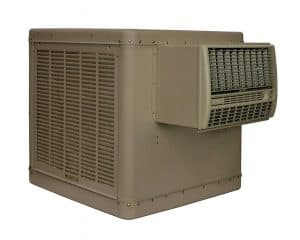 Evaporative coolers are made to cool spaces without using much energy, so if you buy this unit, you will see that it’s amazingly energy efficient! Its media pads are both durable and economical because they’re made from Aspen tree fibers in a thin plastic netting.
Evaporative coolers are made to cool spaces without using much energy, so if you buy this unit, you will see that it’s amazingly energy efficient! Its media pads are both durable and economical because they’re made from Aspen tree fibers in a thin plastic netting.
When it comes to its construction, this unit doesn’t disappoint. It has a bolted construction, which means you can easily access all the parts for potential replacement, and it’s also highly durable. You can keep it in damp areas because it’s resistant to rust.
Made from heavy-gauge galvanized steel and with a polyester powder coated finish, you can be sure this unit will last for a long time. You can even keep it in uneven areas because it features a leveling leg.
It gets even better:
Another great feature of this unit is that it’s unusually quiet for a unit of its size. It also features a permanently lubricated pump. The Essick N46W comes put together and ready to use – simply connect it to a water supply and it’s good to go.
And the good news is that you don’t have to call a plumber or professional to install this unit. The installation kit comes with the product, and we’ve found that the installation process itself is a breeze even for amateurs.
The only downside to this unit is that it’s quite large and heavy. It doesn’t feature wheels, so it can be a pain to move around.
Resistant to rust
Highly durable
The Phoenix BW4002 is a great evaporative cooler if you need something that will cool medium to large spaces. Made by a highly-reputable company, Phoenix Manufacturing, this unit is durable and reliable. Our research showed that the company is responsive and reliable when it comes to keeping their warranties.
Partly because of its size, the unit is not suitable for smaller spaces. It also doesn’t feature rollers, so it’s not convenient to move around. The device itself is not portable, which means it has to be hooked up to a water supply. But luckily, the installation is very simple and our research shows that it can be done by an amateur in less than half an hour.
This is crazy:
The CFM of this unit is an impressive 4,000, and it features two easily adjustable cooling speeds. It’s designed to give you lower temperatures for less money. It delivers more CFM per watt than the majority of other models out there.
This evaporative cooler is built with high-quality materials and is designed to be durable and reliable. It features an exclusive MIRROSCOPIC blower shaft finish process which can yield 90% more than the standard finish most coolers use. What this means for you is that the unit is much quieter, and the bearings and shafts last much longer than with other coolers.
This unit also features a sump pump, and the cooler doesn’t have to be refilled. Low maintenance and powerful cooling are the names of the game here. It lowers energy consumption by up to 28% and cools the air in a room very quickly.
You might be saying:
This cooler sounds too good to be true. That’s because we haven’t gotten to its flaws yet. The biggest downside to the Phoenix BW4002 is that it’s large and heavy. But if you want to efficiently cool a larger room and don’t plan to move the unit around a lot, it’s still a great choice.
Another downside is that, in case a part malfunctions and is not covered by warranty, replacement parts can be a hassle to track down. But once you do, they’re easy to replace.
Doesn’t need to be refilled
15 to 28% reduced energy cost
Large and heavy
Replacement parts can be difficult to find
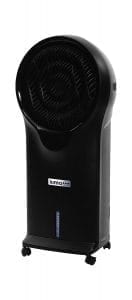 If you have a small to medium-sized room which needs cooling, the Luma Comfort EC111B is a great choice. Luma Comfort is a quality company with a sturdy reputation for making stylish and functional coolers, and this one is no exception.
If you have a small to medium-sized room which needs cooling, the Luma Comfort EC111B is a great choice. Luma Comfort is a quality company with a sturdy reputation for making stylish and functional coolers, and this one is no exception.
The EC111B is a portable cooler, which means that it doesn’t attach to a water supply line, but instead has a tank that’s manually filled with water and ice. This unit is one of the few ones out there which have a completely removable tank. The tank has a two-gallon capacity, is very easy to remove, clean and fill, and the overall unit is very low-maintenance.
The EC111B can be used as a primary cooling source, but it can also be used as a supplemental cooling source, similar to how quality space heaters are used as a secondary heating option. This unit can lower indoor temperatures by as much as 30 degrees. It has a CFM of 500 and it’s optimal for rooms of a size up to 250 square feet. The unit features rollers, which makes it easy to move around.
But hear this:
This unit also features a timer which can easily be programmed, and which saves both effort and energy. The EC111B features both a humidifier and a tower fan. The fan has three speeds and wind modes, including oscillation, and a handy remote control feature.
The display on the unit is very user-friendly, and we’ve found that even users that have never used an evaporative cooler have no problems adjusting the settings or programming the machine. The control buttons are simple and the control panel is easy to read, which makes it a great choice for older people.
And how about this:
One of the best features of Luma Comfort coolers is their stylish design. Our research showed that, when it comes to eye-catching design, this cooler is a top choice. Most other coolers have an industrial design, while the EC111B is a perfect addition to any interior decorating style. The unit is also quick and simple to set up – simply take it out of the box, pour water/ice in, and turn it on.
Since this product is meant to be used in small and medium indoor spaces, the size of the unit is small, and so is the size of the tank. As a result, one of the downsides of this unit is that the tank needs to be refilled quite often.
Water tank easy to manage and clean
Visually enticing
A good evaporative cooler saves you from heat exhaustion, but a great one makes you feel as if you were transported into a truly pleasant climate. Choosing such a device requires some thinking, but it’s not as complicated as you might think.
First, you need to decide where you’ll be using your unit – indoors or outdoors, in a single or multiple rooms, in a small or large space.
Next, come the issues with the water supply – connecting the cooler to a supply line or getting one with a tank. You should also think about energy consumption since there are more and less power-consuming devices.
And last but not least, you need to decide if you want any of the tempting special features a lot of coolers offer.
What’s the climate like where you live?
If you were to ask yourself only one question before you went and bought an evaporative cooler, it should be this one. It’s because this type of device doesn’t work the same everywhere.
For further information and tips on determining whether an evaporative cooler is a good choice for your climate, check our What’s the climate like where you live section.
It’s that important.
Nobody wants to get stuck with a cooling device that doesn’t do its job right. Unfortunately, to avoid this, you’ll need to put some effort into the process of choosing one. There are plenty of amazing evaporative coolers out there, but the fact they’re well designed and fully functional doesn’t mean they’re the right choice for you.
You’re probably thinking It shouldn’t be that hard to pick a cooling device.
Let me just say this…
We thought the same thing when we started working on this guide. But turns out, it’s bit more involved than you’d think.
So to help you avoid making a mistake with evaporative coolers, we bring you all the information you need, along with some questions that should help you make your decision.
What are evaporative coolers really and how do they work?
You already know they’re a type of cooling device, which means their main purpose is lowering temperature. And that’s exactly what an evaporative cooler does, but there’s still a big difference between them and other devices of the same type. It’s in the way they achieve their purpose: the process of lowering temperature.
Now:
An evaporative cooler is a device that uses water for cooling purposes. As we’ll see in the following paragraphs, not all of them boast the same features, but this is the one thing they all have in common.
You fill their water tanks or connect them to your water supply line and almost immediately, they start blowing out cooler air. This is called evaporative cooling.
Here’s how it works:
The water from the cooler’s tank soaks the pads located within the device. These are followed by a fan that sucks the hot air from behind the wet pads. While it goes through them, the air automatically becomes cooler. From the other side of the fan, you start feeling a welcome breeze, but the air gets more humid, too.
 There’s more than one way to keep yourself cool during the summer. Besides evaporative coolers, other commonly used devices include fans and AC units. If you haven’t even considered them, now’s the time to do so. You might end up realizing an evaporative cooler isn’t the best choice for you.
There’s more than one way to keep yourself cool during the summer. Besides evaporative coolers, other commonly used devices include fans and AC units. If you haven’t even considered them, now’s the time to do so. You might end up realizing an evaporative cooler isn’t the best choice for you.
So the question is:
What are the differences between these three types of devices? In other words, when should you choose a fan, when an evaporative cooler, and when an AC unit? Let’s check them out one by one, so you’ll be able to browse their features more easily.
A fan has obvious limitations – you don’t have to be an expert on cooling to know that it’d be a lot less powerful than any evaporative cooler or AC unit. However, if you live in a tropical climate, it might just be the best choice for you, at least according to House Energy. Since you’re already struggling with high levels of humidity, you don’t need an evaporative cooler to raise them even more. And using AC would be way too expensive, since it’d have to be running all day long, while using a fan is the cheapest possible option.
Evaporative coolers humidify the air, which makes them an excellent choice for those living in hot, dry climates. But that also means they shouldn’t be used in places with high levels of humidity. They need the circulation of fresh air to operate, meaning they’ll never make it feel stale. One of their biggest advantages is lower energy consumption than that of AC units, which makes them cheaper for the user and safer for the environment.
AC units spend a lot of energy to keep you cool, which translates into a roughly 50% higher cost and greater environmental impact. Also, you can’t keep the windows open while they’re running, which might be a big downside if you’re living in an already dry climate. But if the air in your space is both hot and humid, an AC unit could be the way to go.
You’ve read about the differences between a fan, an AC unit, and an evaporative cooler, and it still seems the latter is the best choice for you. However, you still need to choose between different types of evaporative coolers.
Here’s what you should know:
Basically, there are three types of evaporative coolers: industrial, residential, and window-mounted.
But don’t let the names fool you into thinking you already know exactly what you need.
Each type has its own set of pros and cons, and you should take them all into account before making your final decision.
According to Webopedia, CFM stands for cubic feet per minute. It measures the speed at which air flows out from a cooling device. The higher the speed, the more power the device has.
When it comes to evaporative coolers, units with higher CFM numbers are usually meant for cooling larger spaces. This, however, doesn’t mean they’re a better choice for everyone. For tips on choosing a cooler with the right CFM number, check our Are you trying to reduce energy consumption section.
Industrial evaporative coolers are usually bigger and heavier, as well as more difficult to move around. This is because they rarely feature rollers or any other type of casters used to transport heavier items. However, this type of cooler also boasts a higher CFM, making it more suitable for cooling larger areas and outdoor spaces.
Most residential evaporative coolers boast both better-looking and lightweight design. They’re usually equipped with rollers, which makes it easier for you to move them around. Since their CFM is lower, they’re only suitable for cooling indoor spaces. You’ll find that the majority works best in small to medium-sized rooms.
Window-mounted evaporative coolers shouldn’t be used for industrial purposes since they’re usually as powerful as residential units. Although they’re efficient in cooling small to medium-sized spaces, you won’t be able to move them once you’re done with the installation process.
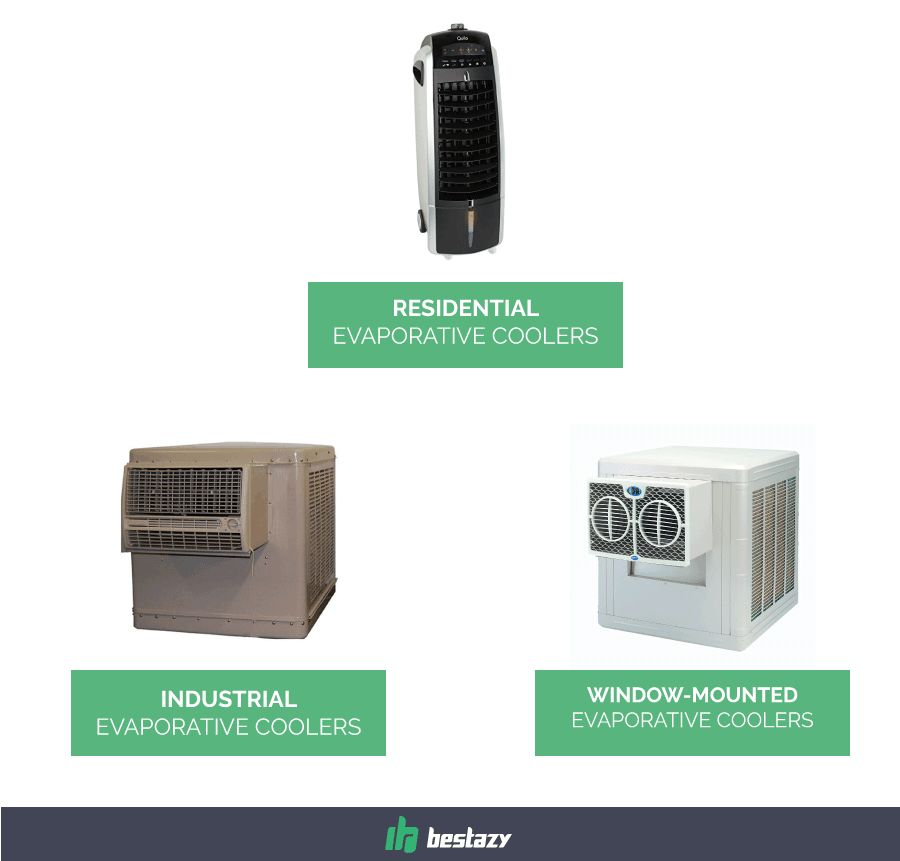
There’s one upside, though.
Most of them are very easy to mount and come with all the necessary tools.
 Evaporative coolers are also known as swamp coolers, but it’s very important not to let this choice of words fool you. When someone says ‘swamp cooler’, it’s only logical to think of an appliance used to cool hot, humid areas. After all, those are the defining characteristics of swamps, right?
Evaporative coolers are also known as swamp coolers, but it’s very important not to let this choice of words fool you. When someone says ‘swamp cooler’, it’s only logical to think of an appliance used to cool hot, humid areas. After all, those are the defining characteristics of swamps, right?
But a swamp cooler simply wouldn’t work in those conditions. As we said before, it’s meant to be used in hot, dry climates. This is because it not only cools but also humidifies the air that surrounds it. It’s also the main reason why you should take your climate into account before opting for this cooling method.
What does that really mean?
Sure, the part about your climate being hot couldn’t exactly be seen as a source of confusion. After all, if you’re in search of a cooling method, it’s hot enough for you to use an evaporative cooler.
But how can you tell if your climate is dry enough?
Any area with average humidity levels of 60% or less is dry enough for evaporative coolers. If you don’t know where to place your home, do some research – it shouldn’t take more than a couple of minutes. In general, however, it’s the west half of the US that falls into this category.
The purpose of every such device is to cool the space in which you keep it, but different types of evaporative coolers excel in different tasks.
Here’s the deal:
If you’re looking for a cooling method for a specific room in your home, and don’t plan on moving the unit at all, get yourself a window-mounted evaporative cooler. These are very efficient, easy to install, and you don’t have to think about them much once you mount them.
It’s a different story if you’re looking for something that will cool you, no matter where you are in your home. You might need your cooler running in your study throughout the morning, but would like to be able to move it to your living room in the evening. In that case, it might be best to opt for a lightweight residential evaporative cooler with rollers.
On the other hand, if the space that needs cooling is a garage or a backyard, you’ll need something with more power. Since you wouldn’t have to move it around, an industrial evaporative cooler should do the trick. These don’t have rollers, but they’re efficient and quite powerful.
Your choice of evaporative cooler should also depend on whether you plan on moving it around or not. There are two different options if you don’t, and one if you do.
Here they are:
If you’d like to be able to move your cooler around, steer clear of window-mounted and industrial units. Residential evaporative coolers are the way to go since they’re the only ones with rollers.
In case you don’t plan on moving the unit, you can go with both window-mounted and industrial evaporative coolers. You can place the latter anywhere you want, but the former, as the name itself suggests, need to be mounted on a window.
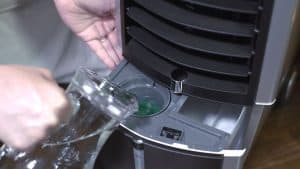 Would you be able to do the refilling of the water tank?
Would you be able to do the refilling of the water tank?Let’s say you need to keep a space cool even when you’re not in it. The thing about most evaporative coolers is that their water tanks need to be refilled every couple of hours. This might prove to be very inconvenient for you.
But guess what:
There are coolers that don’t need to be refilled at all. True, they’re all industrial units, but that doesn’t necessarily mean it wouldn’t be a good choice for you. Instead of filling its tank with water, you’d only need to connect it to your water supply. It’ll draw just the right amount of water to keep itself running, and you won’t have to think about it at all.
Evaporative coolers come in different sizes, which is why you shouldn’t buy one without checking its dimensions first. Take into account how much space you can spare since there’s a big difference between industrial and residential units. And even among the latter, there are both more robust and more compact coolers.
 This might not matter to you all that much if you’re looking to cool a larger space. However, if you live in a small apartment, the amount of noise produced by your evaporative cooler might make a big difference. Make sure to look for notes on this when going through our detailed reviews of individual products. But what if it’s the more aggressive air current produced by the device that bugs you?
This might not matter to you all that much if you’re looking to cool a larger space. However, if you live in a small apartment, the amount of noise produced by your evaporative cooler might make a big difference. Make sure to look for notes on this when going through our detailed reviews of individual products. But what if it’s the more aggressive air current produced by the device that bugs you?
Here’s where it gets good:
Some coolers feature sleep modes that help you notice them less, even when lying in bed at night. They do it by imitating the way air flows in nature. This is especially useful for families with babies.
If the answer is yes, don’t even think about buying an AC unit. Evaporative coolers spend so much less energy it makes comparing the two laughable. However, there is something you can do to cut back on your expenses even if you opt for a cooler. And it involves choosing a unit with the right CFM.
Do this:
Multiply the number of square feet you need to cool by ceiling height, measured in feet. Divide the number you get by 2, and you’ll get the CFM.
If you do that:
You’ll avoid wasting energy trying to cool a space with a device that’s just not up for the task. You’ll also avoid wasting money on a device with more power than you’ll ever need. Instead, you’ll get the ideal CFM for the space you want to cool.
So far, we’ve mostly been talking about the general characteristics of evaporative coolers. However, there’s so much more to them than that, at least when it comes to residential units. That’s why we’re going to take a minute to give you a quick tour of some of their most common special features.
Let’s check them out:
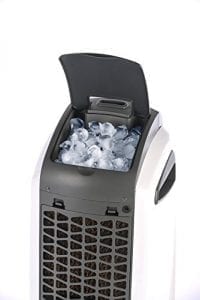 Some coolers can only be controlled manually, but there are plenty of those with remote control options and LED displays. If you opt for one of these, you’ll get a controller that will enable you to turn on and shut down the device remotely. Of course, you’ll also be able to change its settings. This might really come in handy to those living in larger spaces.
Some coolers can only be controlled manually, but there are plenty of those with remote control options and LED displays. If you opt for one of these, you’ll get a controller that will enable you to turn on and shut down the device remotely. Of course, you’ll also be able to change its settings. This might really come in handy to those living in larger spaces.
When you want it to be faster at lowering the temperature, you can feed your cooler ice. But not every unit has a separate ice compartment. These help improve the cooler’s performance, at least when it comes to speed. If you like the sound of that, make sure to look for this feature when going through our detailed reviews of individual products.
Think you’d be annoyed by constantly having to check the level of water in the cooler’s tank? The solution is very simple – look for units equipped with water-level sights. These are openings in the exteriors of coolers that let you see how much water there’s left in the tank without having to open it.
All evaporative coolers make the surrounding air more humid, and there’s no way around that. However, some of them allow you to control the levels of humidity in the space they’re cooling. You do this with the help of humidification knobs with multiple settings.
Some coolers come with specially made air filters. Apart from cooling the air that goes through them, they also eliminate dust and many other harmful particles it may contain. This makes the air you breathe a lot cleaner.
Worried about forgetting to turn your cooler off? It’s not a real issue, at least if you invest in a unit that’s equipped with a timer. These allow you to set your cooler to keep running for a specific length of time, before automatically shutting down.
Some coolers can be set to work in a pre-programmed sleep mode. They don’t always go by that name, but they all have one thing in common. Imitating the natural flow of air, sleep modes make the process of cooling less obtrusive. Since this is especially important during the night, they’re usually explained as a feature that improves the quality of sleep.
Portacool PAC2KCYC01 Cyclone 3000 Portable Evaporative Cooler
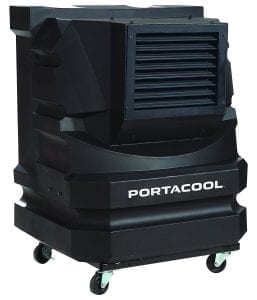 Do you want an evaporative cooler that’s efficient and doesn’t use much energy? We’ve got one that fits the bill. The Cyclone 300 from Portacool is a high-quality cooler which is resistant to rust and cannot leak. It’s extremely energy efficient – the pump and motor function at 5.6 amps, and it uses only 120 volts of power, which is less than half of what other, smaller units tend to use.
Do you want an evaporative cooler that’s efficient and doesn’t use much energy? We’ve got one that fits the bill. The Cyclone 300 from Portacool is a high-quality cooler which is resistant to rust and cannot leak. It’s extremely energy efficient – the pump and motor function at 5.6 amps, and it uses only 120 volts of power, which is less than half of what other, smaller units tend to use.
It also doesn’t use refrigerator gas and has a cooling capacity of 700 square feet. It features high-quality evaporative pads – KUUL Pads with media. This means you can use tap water to run it and the air produced will be 10 to 25 degrees cooler.
For a cooler that can efficiently cool down a room of a medium to large size, it really doesn’t use up much power. So if you’re going for maximum energy efficiency, this cooler is a great choice.
Luma Comfort EC111B Portable Evaporative Cooler
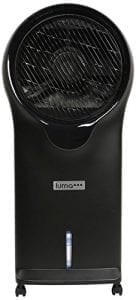 The Luma Comfort EC111B is a great choice for small rooms. Made by Luma Comfort, this quality cooler is sturdy, well-designed and aesthetically pleasing. This unit is a portable one, so you don’t have to attach it to a water supply line – it has a completely removable two-gallon tank which is easy to remove, clean, and fill, which makes the unit very low-maintenance.
The Luma Comfort EC111B is a great choice for small rooms. Made by Luma Comfort, this quality cooler is sturdy, well-designed and aesthetically pleasing. This unit is a portable one, so you don’t have to attach it to a water supply line – it has a completely removable two-gallon tank which is easy to remove, clean, and fill, which makes the unit very low-maintenance.
This cooler also features rollers, which makes it easy to move around. The fan on the cooler has three speeds and wind modes, including oscillation, and a handy remote control feature. It also features a user-friendly display which is easy to use and read.
Finally, what could be said is the best feature of the Luma is its stylish design. We have found that, when choosing by design, this cooler is many people’s top choice. It can fit any interior decorating style and isn’t an eyesore, like some other coolers out there. So if you have a small space and want something that looks stylish, this cooler is the right choice.
Phoenix Manufacturing BW4002 Evaporative Window Cooling Unit
 The Phoenix BW4002 is a good choice for medium to large spaces. It’s durable and reliable, and the installation is very simple. So if you want a cooler that can cool down a large room in no time, this one is a good choice.
The Phoenix BW4002 is a good choice for medium to large spaces. It’s durable and reliable, and the installation is very simple. So if you want a cooler that can cool down a large room in no time, this one is a good choice.
When it comes to power, this unit has a CFM of 4,000, which is a lot more than most other coolers out there. It’s designed to provide more cooling power for less, so it gives you more CFM per watt than other coolers. Basically, with a CFM that high, it can cool down a large room in a matter of minutes!
It also features a MIRROSCOPIC blower shaft finish process that yields 90% more than the standard finish most coolers use. Basically, this unit is quiet, powerful, and gets the job done. So if you want quick cooling at a 28% lower energy consumption, the Phoenix BW4002 is a good choice.
Quilo QE1SKS 3in1 Quiet Low Energy Portable Tower Fan with Evaporative Cooler & Humidifier
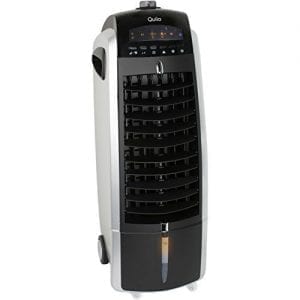 If you want the convenience of having an evaporative cooler, but can’t stand the noise they make, the Quilo QE1SKS might be the right choice for you. Many people would like a cooler room, but detest the noise and humming sounds coolers make. But we’ve found perhaps the quietest cooler on the market!
If you want the convenience of having an evaporative cooler, but can’t stand the noise they make, the Quilo QE1SKS might be the right choice for you. Many people would like a cooler room, but detest the noise and humming sounds coolers make. But we’ve found perhaps the quietest cooler on the market!
This cooler is great for small spaces, has three cooling speeds, and an automatic off timer. It features three separate appliances in one – a fan, an evaporative cooler, and a humidifier. The 1.85-gallon water tank can easily be removed, and it features a filter that prevents dust and other particles from entering the tank.
You can use it to mimic a lovely natural breeze in your home – without the usual noise that comes with it. The fan is incredibly silent when running in a normal mode, but it also has a quiet mode that uses as little as 7.4 W. Our research has found that it barely makes a sound! So if you want something quiet but efficient, this is the one.
Honeywell 525 CFM Indoor Portable Evaporative Cooler with Fan & Humidifier
 Whether you’re looking for lower temperature, higher humidity, or a breeze in your home, the Honeywell 525 CFM has it all. It’s meant to be used in small to medium spaces and it has a CFM of 525, as well as a cooling capacity of 320 square feet. It’s amazingly functional and can easily be adjusted to fit various needs – perfect for a home with people of different preferences living in a single space!
Whether you’re looking for lower temperature, higher humidity, or a breeze in your home, the Honeywell 525 CFM has it all. It’s meant to be used in small to medium spaces and it has a CFM of 525, as well as a cooling capacity of 320 square feet. It’s amazingly functional and can easily be adjusted to fit various needs – perfect for a home with people of different preferences living in a single space!
This unit has three functions in one compact appliance – a fan, a cooler, and humidifier. The fan can be adjusted to imitate natural wind, the cooler provides a powerful airflow while using little power, and in the winter you can easily add humidity to any room with the touch of a button.
This unit is easily adjustable – it features three cooling speeds, including Sleep Wind Mode. The humidity can be adjusted by simply turning a knob. There’s also an off timer, a low-water-level alarm, and a full-function remote control.
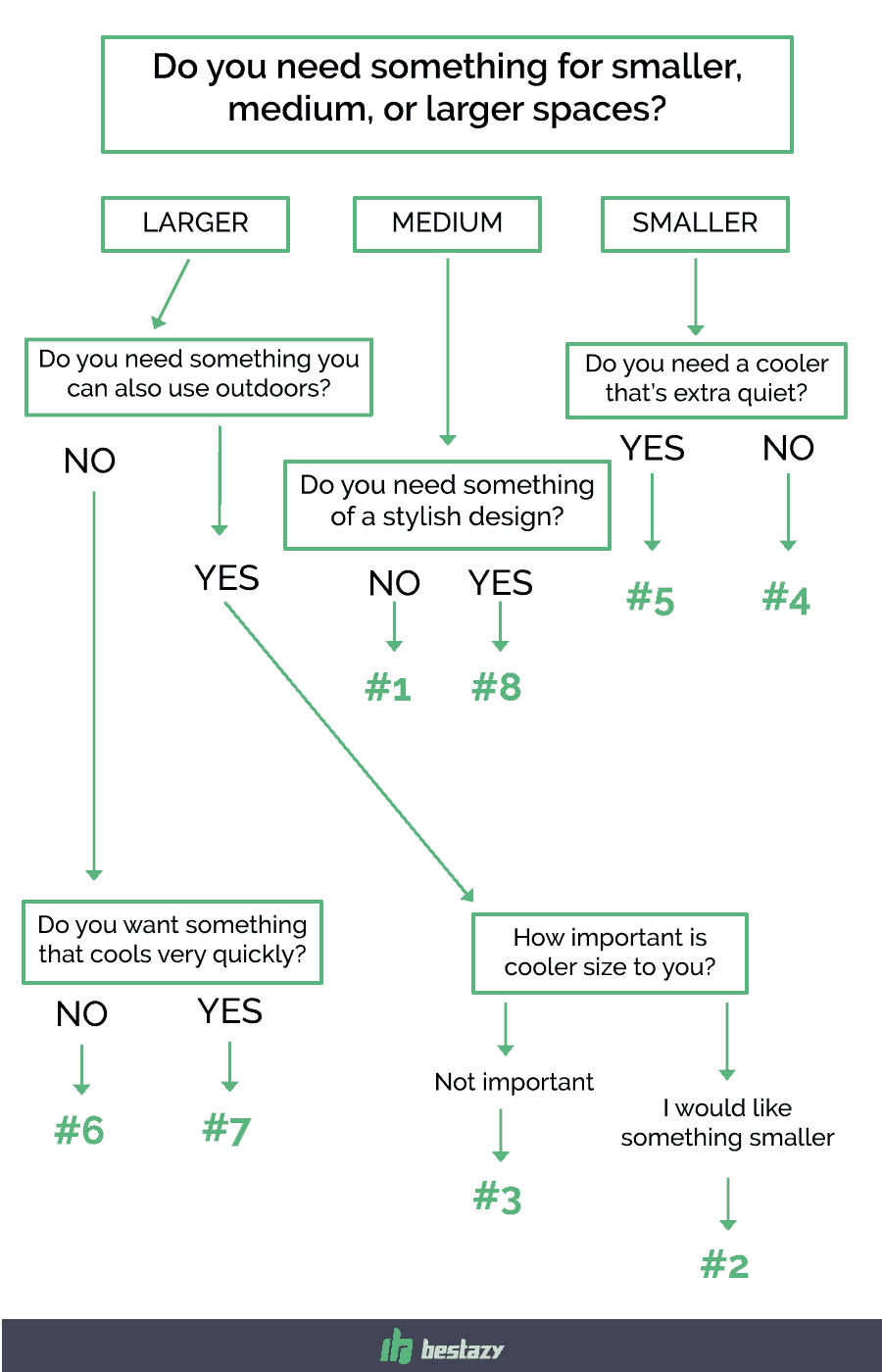
Once you’re done picking out your cooler, you can move on to making sure you get the most out of it. Proper installation and maintenance can make a world of difference when it comes to the way your unit performs. Check out the following tips and prolong the life of your new cooler. We’ll start from the beginning – the process of installation.
 Did you end up choosing a cooler that needs to be mounted on a window? Luckily, they all come with instructions and all the tools you might need to install them. However, that doesn’t mean you won’t benefit from someone leading you through the process. In any case, you’ll need some tips on how to connect your new cooler to your water supply line.
Did you end up choosing a cooler that needs to be mounted on a window? Luckily, they all come with instructions and all the tools you might need to install them. However, that doesn’t mean you won’t benefit from someone leading you through the process. In any case, you’ll need some tips on how to connect your new cooler to your water supply line.
Here it goes:
According to Hunker, a DIY installation shouldn’t give you much trouble. But before you start, make sure you have everything you need at hand. This includes not only the kit that came with the product, but a drill, level, and wrenches as well.
Step 1
Take out and assemble the support brackets following the instructions provided by the manufacturer. Using your drill and parts from the installation kit, mount the brackets on the outside wall of your home. Do it so that they’re able to support the back side of the cooler while it rests on the windowsill. Make sure to use the level and to properly tighten all the parts.
Step 2
Lift the cooler itself and lay it on the windowsill. The vent should be resting on the support brackets. Follow the manufacturer’s instructions to attach the unit to the brackets. Once again, make sure everything’s fixed in place.
Step 3
Go to your water supply line and turn the water off. Using a wrench, remove the valve to replace it with the one you got as part of the installation kit. It should have an opening that’s a quarter of an inch wide. Fix it onto the water pipe, making sure it’s properly tightened.
Step 4
Get your newly installed water supply line to the cooler. The part you’re supposed to connect to the unit should have a tightening nut and a compression sleeve. You’ll find the cooler’s connection opening at the back of its housing. Thread and tighten the nut using your wrench. As you do that, the compression sleeve will adjust itself automatically.
Step 5
Once you’re done connecting the cooler to your water supply line, turn the water itself back on. Check for possible leaks on both ends of the line. If you spot any, simply tighten the nut some more. It should do the trick. In any case, this will be the last step in your installation process.
 We’ve already mentioned that evaporative coolers raise the levels of humidity in the surrounding air. Although you can’t do anything to stop them from doing that, you can make sure the airflow they produce is balanced. According to Save With SRP, this, in turn, will limit the levels of humidity and give you much better cooling results. But how exactly do you make sure your cooler produces a balanced air flow?
We’ve already mentioned that evaporative coolers raise the levels of humidity in the surrounding air. Although you can’t do anything to stop them from doing that, you can make sure the airflow they produce is balanced. According to Save With SRP, this, in turn, will limit the levels of humidity and give you much better cooling results. But how exactly do you make sure your cooler produces a balanced air flow?
Before you do that:
By now, you’re probably aware of the fact that you need to keep a window open while running an evaporative cooler. That’s why you should take the air flow into account before deciding where to put it. The amount of air it blows out is supposed to be the same as the amount of air it draws from outside your home. It might sound complicated, but it’s actually really simple.
Here’s how you do it:
Crack a window in the room in which you’re planning to use your new cooler. There’s no need to have it wide open since you just want the air to start flowing in. Next, open the door and watch what happens. If the air current ends up slamming the door shut, that’s a sign for you to open the window a bit wider. On the other hand, if it doesn’t move at all, it means the window was open too wide.
Now that the air flow in your home is balanced, you can turn the cooler on and start enjoying the fresh air it’s producing.
As you’ll see, caring for an evaporative cooler isn’t a task to be dreaded. However, regular and proper maintenance can significantly prolong its life and improve its overall performance. Window-mounted units need to be dealt with differently than industrial and residential ones, so we’ll explain the process in two separate paragraphs.
Maintaining industrial and residential coolers includes proper cleaning and shutting down at the end of each season. Once every two weeks, use a mild detergent and lukewarm water to clean the device. You can do the housing with a damp cloth. No big deal, right?
If all this sounds a bit much, maybe you’d benefit from seeing someone else do it first. There are plenty of videos on YouTube that are basic explanations of how to do a proper cleanup of evaporative coolers before the start of the season. However, the one right here is among the best that we’ve seen. It includes the process of cleaning pads, checking the parts for damage, and lubricating the device so that it continues working optimally.
Now:
When you’re ready to shut down and store your cooler for a longer period of time, make sure to do one last cleaning first. Then, drain its water tank completely, and clean both the filter and the water curtain. Finish by running the fan for about 30 minutes, so that the unit can dry completely.
Maintaining window-mounted coolers includes preparing them for use and shutting them down for the season. If you’re getting ready to run your cooler, it’s important to change its pads and clean its pump, but you can also oil the motor. When you want to shut it down, drain the water from both the cooler and the water supply line, disconnect the line itself, and unplug and cover the cooler.
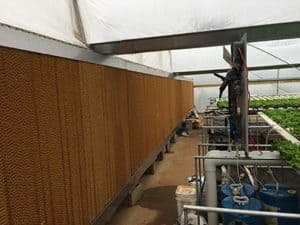 Wondering about those cooler pads we mentioned a minute ago? You can find them in every industrial and residential unit, although you’re not supposed to have them forever. They need to be changed every once in a while, but that shouldn’t be a cause for concern. We’ll tell you all you need to know about different types and exactly how often you should replace them.
Wondering about those cooler pads we mentioned a minute ago? You can find them in every industrial and residential unit, although you’re not supposed to have them forever. They need to be changed every once in a while, but that shouldn’t be a cause for concern. We’ll tell you all you need to know about different types and exactly how often you should replace them.
Here it goes:
Basically, cooler pads are what makes it possible for the device to cool the air it draws from the outside. This is achieved by getting the pads wet and placing them inside the housing so that the air is forced to go through them. As a result, the air that the device blows out is noticeably cooler than when it came in. There are two types of cooler pads that are most widely used: rigid pads made from cellulosic materials and fiber ones.
Rigid pads look a lot like cardboard pieces that have been firmly pressed together. They’re very efficient when it comes to cooling, as well as quite durable. You can even clean and reuse them once they get dirty, but they’re not used as much as their fiber counterparts. In all likelihood, it’s simply because they’re pricier.
When it comes to fiber pads, there are two subtypes: Aspen and synthetic fiber pads. The latter are made using synthetic shavings and are quite efficient. But they have some additional upsides working for them, such as resistance to mold and break down. This makes them more durable, although they are prone to calcium buildup. Plus, you can clean and reuse them, just like the rigid pads.
Aspen pads, on the other hand, are made using real wood shavings. Since they’re pretty cheap, you’ll find them in most coolers, no matter the type. They work well and smell really nice, but they have a downside as well. Namely, they’re not as durable as the other types of cooler pads, which might be a deal breaker for some.
Now:
About the frequency with which you should replace the pads. This depends on a number of factors, including the brand you’re using, how often you run your cooler, and the quality of the water with which you’re supplying it. If you’d like to avoid unnecessary replacements, check the manufacturer’s instructions and keep an eye on how quickly your pads are deteriorating.
However:
If you’d still like to know what to expect, we can tell you with certainty that Aspen pads need to be changed more often than the other types. Most people replace theirs at the beginning of each season. On the other hand, rigid and synthetic fiber pads can last for three to five years. Of course, provided that you clean them at least once a year.
If you listen to our advice on maintaining your evaporative cooler, chances are it’ll serve you well for years to come. Of course, you shouldn’t take this as a guarantee of any kind. All things break eventually, and at some point in the future, this could happen to your cooler as well. Luckily, most of them come with warranties.
Now:
The kind of warranty you get will depend on the device you end up choosing. Typically, damage due to rust and similar factors gets treated differently than mechanical breakdowns. That’s why you’ll get an extended warranty for rust protection, while the one for parts will get you cover for a year or maybe two. But whatever happens to your cooler, make sure you get it fixed as soon as possible.
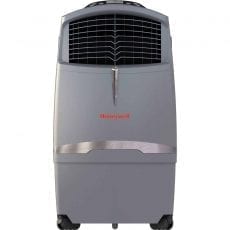
Winter is coming. Eventually. But right now you need the best evaporative cooler to keep you cool this summer. Read our reviews before you buy!
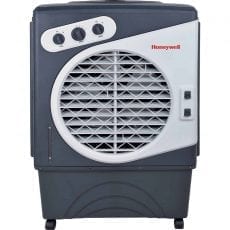
Winter is coming. Eventually. But right now you need the best evaporative cooler to keep you cool this summer. Read our reviews before you buy!
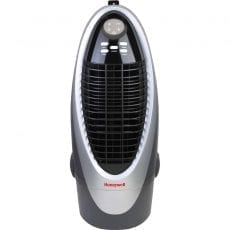
Winter is coming. Eventually. But right now you need the best evaporative cooler to keep you cool this summer. Read our reviews before you buy!
When trying to determine what size cooler you should get, the first thing to do is to calculate your optimal CFM. This is the number of cubic feet of airflow per minute your new cooler should have to be able to cool your room at an optimal rate.
To find out what CFM you need, simply take the number of cubic feet of the room you want to be cooled and divide it in half (if you’re not sure about the height of the ceilings, 8 feet is a popular estimate). The number you get is the optimal CFM that you should look for in an evaporative cooler.
But CFM is not everything. It only tells you how much air the unit can push out – how fast the cooler can cool. What you also need to do is see the specifications of the cooler, and make sure it has a cooling capacity close to the size of your room.
CFM is an acronym meaning cubic feet per minute. It’s a unit that’s commonly used to measure how much air an item can blow out. It’s usually used with coolers, fans, and similar devices. A CFM indicates how much air a device is capable of blowing out in one minute.
When looking at evaporative coolers, the CFM ratings are very important. When a fan has a high CFM rating, it basically means it can cool down a larger area more quickly, because it can blow out a lot of cool air in less time.
Evaporative coolers are very safe. Many people think that, because they’re so efficient, there’s some risk involved in running an evaporative cooler. But the opposite is true.
Because there aren’t any chemicals, refrigerants, or coolants used, cooling a room down with an evaporative cooler is a very natural process. Basically, what cools down the room is only the water the cooler uses and turns into vapor.
It’s true that evaporative coolers transform water into vapor, so many people tend to think that maybe everything in a room with a cooler will become damp and moist. But there’s no need to worry – the opposite is true. The coolers do turn water into vapor, but they also have water pads in their air ducts, which prevent your room, furniture, and stuff from becoming damp or moist.
Portable coolers are evaporative coolers that can be moved and transported from room to room easily. They usually feature rollers or wheels and are smaller and more compact than non-portable units. But usually, the main difference between portable and non-portable coolers is that portable coolers feature a water tank you need to refill with water and/or ice yourself, while non-portable coolers can often be attached to water supply lines. Both types have their pros and cons. Namely, portable coolers are usually smaller, can be moved around, and are easily positioned, and non-portable coolers don’t have to be refilled.
If you’ve decided on a cooler which has a tank that needs to be refilled, the frequency with which you need to refill it varies according to multiple factors, some of them being frequency of use, tank capacity, running speed, etc. If you want to use your cooler all day long, but don’t want to refill the tank often, look for coolers with a big tank capacity like the Honeywell CO60PM which has a 15.9-gallon capacity. On the other hand, if you don’t plan on using the cooler that much, a lower-capacity tank will probably fit your needs.?tag=bestazy-20
Most evaporative coolers require little or no maintenance. They just need to be cleaned every so often (depending on the usage). Generally, we’ve found that most users can get by with cleaning the filters once at the beginning of the season. However, if you use your cooler a lot, you might have to clean the tanks once a month, or even once a week.
Generally, if the cooler seems to be running with less efficiency, look into it, and make sure the filter and pipes are clean. Also, clean out the tank if you notice a smell. Luckily, all the coolers on our list require little maintenance and the tanks are easily accessible/removable for easy cleaning.
If you use your cooler a lot, the tank can be a breeding ground for mildew and various microorganisms. If you start noticing discoloration or smells coming from the tank, simply remove it, clean it in the tub or sink, and let it dry before you continue using it. You can use simple dish detergent to clean the tank, but if you want something more natural, you can always use lemon juice or vinegar. Also, the cooling media should be cleaned or replaced based on the recommendations by the manufacturer.
Evaporative coolers are designed to cool rooms, not entire houses. Many people mistakenly buy a cooler thinking it works like an air conditioner, and expect one cooler to be enough for a whole house. Unfortunately, if you want your whole house to be cooled by these devices, then you need one in every room, or you need to transfer a portable cooler from room to room.
